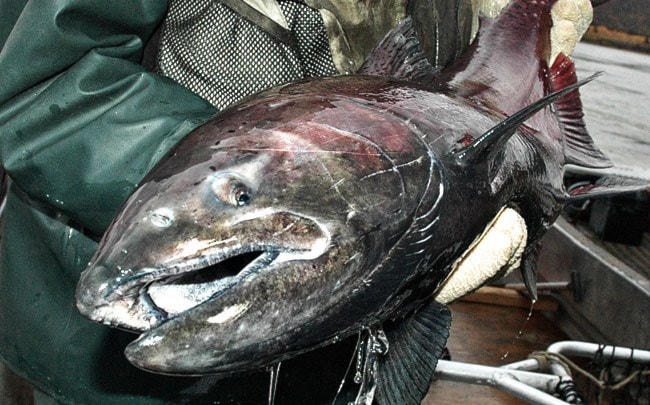Alaska’s Pilot Station sonar system used to estimate chinook salmon escapement figures is skewing the numbers in favour of Alaskan fishers, says an American fisheries researcher.
Canada and Alaska use different methods of estimating the number of salmon in the Yukon River crossing the border — a sonar system in Alaska, a mark-and-capture system in Canada.
The two systems have produced different numbers since Alaska began using the sonar system, leading to disagreements over escapement provisions in agreements between countries.
“The (Alaskan Fish and Game) department has been playing this mixing apples and oranges story big time, and it’s wrong,” said Chris Stark, a researcher at the Institute of Marine Science in the School of Fisheries and Oceans at the University of Alaska-Fairbanks.
“It’s an inaccuracy in a big way … The Canadians won’t put their foot down and say that.
“Canadians are being royally screwed by the United States.”
It’s an Alaskan shell game and at stake are the livelihoods of people living and fishing along the Yukon River, he said.
Border passage numbers specified in the Yukon River Salmon Agreement between Alaska and Canada are based on Canadian Department of Fisheries and Oceans estimates gleaned from its mark-recapture program, by which salmon are tagged and counted throughout the run.
The same number of salmon are crossing the border no matter what system is used for estimates, but the Pilot Station sonar is more accurate, said Stark.
In 2006, the sonar counted roughly 70,000 fish crossing the border, while the mark-recapture counted only 29,000, said Stark.
Because the agreement numbers are based only on the mark-recapture system — essentially an index on which to base decisions about opening or closing fisheries — Alaska claims to meet its treaty obligations using different numbers from DFO.
“If the Alaskans want to use the sonar system, then we should times DFO’s number (by 2.3), and that’s the number that we need to put across the border according to sonar,” said Stark.
Sonar estimates are closer to the real numbers, but the agreements need to be renegotiated if sonar system is used, said Stark.
“We must have an honest discussion about what numbers really mean what,” he said. “The people that want to mix the apples and oranges argument are angling for a better share themselves.”
Earlier this month, low escapement numbers prompted DFO to close the commercial and domestic chinook salmon fisheries on the Yukon River, while recreational fishing is allowed if anglers release their catches.
In previous years, the Alaska Department of Fish and Game has used Canada’s mark-recapture estimates to meet its agreement obligations, said John Hilsinger, commercial fisheries division director for the department.
“We’ve never said we’ve met our requirements using sonar numbers,” he said in an interview with the News.
But in a news release sent out Friday from the commercial fisheries division, officials disagreed with the Canadian estimate of 25,000 to 30,000 salmon crossing the border this year.
“Using two sonar counters (one on each bank) just below the US/Canada border near Eagle, ADF&G’s estimates a larger escapement of about 40,000 chinook salmon. This would be within range of the preseason escapement goal,” said the news release.
When asked about the assertion, Hilsinger, who is quoted earlier in the release, said the statement was inaccurate.
“I would have to look at that again,” he said. “That’s not how I understand it. That is a funny statement. Nobody caught it in the final version.
“We agree by the mark-recapture numbers, the border passage in below the number agreed to preseason. We’re not arguing with that.”
Canada and Alaska fisheries officials will have to discuss the different methods they use at upcoming meetings to stop any further confusion, said Hilsinger.
The Yukon River Salmon Agreement must be renegotiated if sonar numbers will be used in the future, he added, because the sonar system has revealed that more salmon are crossing the border.
Hilsinger would like to see more escapement monitoring on the Canadian side, he said.
“A lot of issues on the Yukon River between Alaskan and Yukon fishermen are related to escapement data,” he said.
“The US would like to see more money allocated (by the Canadian government) to get harder numbers on escapement.”
The disagreement over the use of two different ways to count escapement numbers is an argument that is far from finished, said Stark.
“There’s a misrepresentation of the truth,” he said.
“Until somebody in Canada pulls the trigger, the United States will keep screwing with them.”
